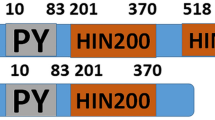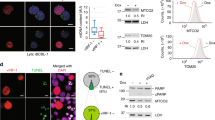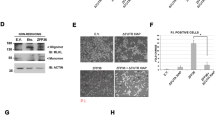Abstract
Expression of an interferon inducible gene 6-16, G1P3, increases not only in type I interferon-treated cells but also in human senescent fibroblasts. However, the function of 6-16 protein is unknown. Here we report that 6-16 is 34 kDa glycosylated protein and localized at mitochondria. Interestingly, 6-16 is expressed at high levels in gastric cancer cell lines and tissues. One of exceptional gastric cancer cell line, TMK-1, which do not express detectable 6-16, is sensitive to apoptosis induced by cycloheximide (CHX), 5-fluorouracil (5-FU) and serum-deprivation. Ectopic expression of 6-16 gene restored the induction of apoptosis and inhibited caspase-3 activity in TMK-1 cells. Thus 6-16 protein has anti-apoptotic function through inhibiting caspas-3. This anti-apoptotic function is expressed through inhibition of the depolarization of mitochondrial membrane potential and release of cytochrome c. By two-hybrid screening, we found that 6-16 protein interacts with calcium and integrin binding protein, CIB/KIP/Calmyrin (CIB), which interacts with presenilin 2, a protein involved in Alzheimer’s disease. These protein interactions possibly play a pivotal role in the regulation of apoptosis, for which further detailed analyses are need. These results overall indicate that 6-16 protein may have function as a cell survival protein by inhibiting mitochondrial-mediated apoptosis.






Similar content being viewed by others
References
Kelly JM, Porter AC, Chernajovsky Y, Gilbert CS, Stark GR, Kerr IM (1986) Characterization of a human gene inducible by alpha- and beta- interferons and its expression in mouse cells. Embo J 5: 1601
Itzhaki JE, Barnett MA, MacCarthy AB, Buckle VJ, Brown WR, Porter AC (1992) Targeted breakage of a human chromosome mediated by cloned human telomeric DNA. Nat Genet 2: 283
Turri MG, Cuin KA, Porter AC (1995) Characterisation of a novel minisatellite that provides multiple splice donor sites in an interferon-induced transcript. Nucleic Acids Res 23: 1854
Porter AC, Chernajovsky Y, Dale TC, Gilbert CS, Stark GR, Kerr IM (1988) Interferon response element of the human gene 6-16. Embo J 7: 85
Tahara H, Hara E, Tsuyama N, Oda K, Ide T (1994) Preparation of a subtractive cDNA library enriched in cDNAs which expressed at a high level in cultured senescent human fibroblasts. Biochem Biophys Res Commun 199: 1108
Tahara H, Kamada K, Sato E, Tsuyama N, Kim JK, Hara E, Oda K, Ide T (1995) Increase in expression levels of interferon-inducible genes in senescent human diploid fibroblasts and in SV40-transformed human fibroblasts with extended lifespan. Oncogene 11: 1125
Rao L, Debbas M, Sabbatini P, Hockenbery D, Korsmeyer S, White E (1992) The adenovirus E1A proteins induce apoptosis, which is inhibited by the E1B 19-kDa and Bcl-2 proteins. Proc Natl Acad Sci U S A 89: 7742
De Laurenzi V, Melino G (2000) Apoptosis. The little devil of death. Nature 406: 135
Capaldi RA (2000) The changing face of mitochondrial research. Trends Biochem Sci 25: 212
Loeffler M, Kroemer G (2000) The mitochondrion in cell death control: certainties and incognita. Exp Cell Res 256: 19
Antonsson B, Martinou JC (2000) The Bcl-2 protein family. Exp Cell Res 256: 50
Nakayama J, Tahara H, Tahara E, Saito M, Ito K, Nakamura H, Nakanishi T, Ide T, Ishikawa F (1998) Telomerase activation by hTRT in human normal fibroblasts and hepatocellular carcinomas. Nat Genet 18: 65
Radinsky R, Bucana CD, Ellis LM, Sanchez R, Cleary KR, Brigati DJ, Fidler IJ (1993) A rapid colorimetric in situ messenger RNA hybridization technique for analysis of epidermal growth factor receptor in paraffin-embedded surgical specimens of human colon carcinomas. Cancer Res 53: 937
Yokozaki H (2000) Molecular characteristics of eight gastric cancer cell lines established in Japan. Pathol Int 50: 767
Hengartner MO (2000) The biochemistry of apoptosis. Nature 407: 770
Li P, Nijhawan D, Budihardjo I, Srinivasula SM, Ahmad M, Alnemri ES, Wang X (1997) Cytochrome c and dATP-dependent formation of Apaf-1/caspase-9 complex initiates an apoptotic protease cascade. Cell 91: 479
Bratton SB, MacFarlane M, Cain K, Cohen GM (2000) Protein complexes activate distinct caspase cascades in death receptor and stress-induced apoptosis. Exp Cell Res 256: 27
Cossarizza A, Baccarani-Contri M, Kalashnikova G, Franceschi C (1993) A new method for the cytofluorimetric analysis of mitochondrial membrane potential using the J-aggregate forming lipophilic cation 5,5′,6,6′-tetrachloro-1,1′,3,3′-tetraethylbenzimidazolcarbocyanine iodide (JC-1). Biochem Biophys Res Commun 197: 40
Cossarizza A, Ceccarelli D, Masini A (1996) Functional heterogeneity of an isolated mitochondrial population revealed by cytofluorometric analysis at the single organelle level. Exp Cell Res 222: 84
Naik UP, Patel PM, Parise LV (1997) Identification of a novel calcium-binding protein that interacts with the integrin alphaIIb cytoplasmic domain. J Biol Chem 272: 4651
Wu X, Lieber MR (1997) Interaction between DNA-dependent protein kinase and a novel protein KIP. Mutat Res 385: 13
Stabler SM, Ostrowski LL, Janicki SM, Monteiro MJ (1999) A myristoylated calcium-binding protein that preferentially interacts with the Alzheimer’s disease presenilin 2 protein. J Cell Biol 145: 1277
Desagher S, Martinou JC (2000) Mitochondria as the central control point of apoptosis. Trends Cell Biol 10: 369
Kaufmann SH, Earnshaw WC (2000) Induction of apoptosis by cancer chemotherapy. Exp Cell Res 256: 42
Vander Heiden MG, Thompson CB (1999) Bcl-2 proteins: regulators of apoptosis or of mitochondrial homeostasis? Nat Cell Biol 1: E209
Sakahira H, Enari M, Nagata S (1998) Cleavage of CAD inhibitor in CAD activation and DNA degradation during apoptosis. Nature 391: 96
Enari M, Sakahira H, Yokoyama H, Okawa K, Iwamatsu A, Nagata S (1998) A caspase-activated DNase that degrades DNA during apoptosis, its inhibitor ICAD. Nature 391: 43
Shimizu S, Narita M, Tsujimoto Y (1999) Bcl-2 family proteins regulate the release of apoptogenic cytochrome c by the mitochondrial channel VDAC. Nature 399: 483
Shimizu S, Konishi A, Kodama T, Tsujimoto Y (2000) BH4 domain of antiapoptotic Bcl-2 family members closes voltage- dependent anion channel and inhibits apoptotic mitochondrial changes and cell death. Proc Natl Acad Sci U S A 97: 3100
Kauselmann G, Weiler M, Wulff P, Jessberger S, Konietzko U, Scafidi J, Staubli U, Bereiter-Hahn J, Strebhardt K, Kuhl D (1999) The polo-like protein kinases Fnk and Snk associate with a Ca(2+)- and integrin-binding protein and are regulated dynamically with synaptic plasticity. Embo J 18: 5528
Foyouzi-Youssefi R, Arnaudeau S, Borner C, Kelley WL, Tschopp J, Lew DP, Demaurex N, Krause KH (2000) Bcl-2 decreases the free Ca2+ concentration within the endoplasmic reticulum. Proc Natl Acad Sci U S A 97: 5723
Zhu L, Ling S, Yu XD, Venkatesh LK, Subramanian T, Chinnadurai G, Kuo TH (1999) Modulation of mitochondrial Ca(2+) homeostasis by Bcl-2. J Biol Chem 274: 33267
Pack-Chung E, Meyers MB, Pettingell WP, Moir RD, Brownawell AM, Cheng I, Tanzi RE, Kim TW (2000) Presenilin 2 interacts with sorcin, a modulator of the ryanodine receptor. J Biol Chem 275: 14440
Gething MJ (2000) Presenilin mutants subvert chaperone function. Nat Cell Biol 2: E21
Acknowledgements
Yeast L-40 strain and pBTM116/HA for yeast two-hybrid screening were kindly supplied by Dr Y Takai (Osaka University, Japan). Anti-GST rabbit pAb was kindly provided by Dr. M. Nakata (Sumitomo Electric Industries, Japan). Anti-human CIB/KIP/calmyrin antibody was kindly provided by Leslie V. Parise (North Carolina University, USA). A mammalian expression plasmid, pCXN was kindly provided by Dr J. Miyazaki (Osaka University, Japan). This work was supported by Grant-in Aid from the Ministry of Education, Science, Sports and Culture of Japan.
Author information
Authors and Affiliations
Corresponding author
Rights and permissions
About this article
Cite this article
Tahara, E., Tahara, H., Kanno, M. et al. G1P3, an interferon inducible gene 6-16, is expressed in gastric cancers and inhibits mitochondrial-mediated apoptosis in gastric cancer cell line TMK-1 cell. Cancer Immunol Immunother 54, 729–740 (2005). https://doi.org/10.1007/s00262-004-0645-2
Received:
Accepted:
Published:
Issue Date:
DOI: https://doi.org/10.1007/s00262-004-0645-2




